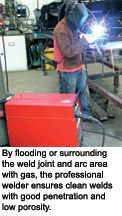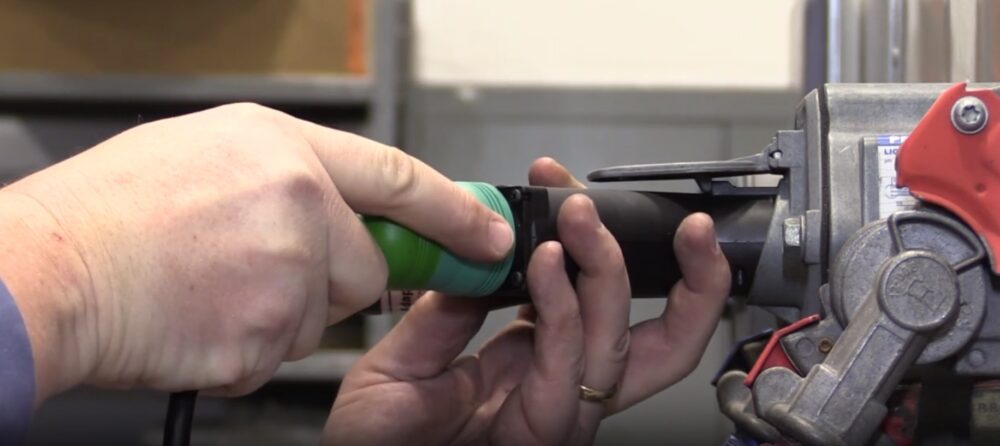 MIG, TIG, stick, gas, gasless, oxy-acetylene, deep penetration, spot welding, plastic welders, pulse technology, high strength steel — if it seems like welding has gotten more complicated than you remember — it has!
MIG, TIG, stick, gas, gasless, oxy-acetylene, deep penetration, spot welding, plastic welders, pulse technology, high strength steel — if it seems like welding has gotten more complicated than you remember — it has!
Today’s auto industry faces many challenges that are shaping and changing the way we stick two pieces of metal together. Once upon a time, a welder would grab a new electrode, stick it in his welder and set about repairing most any metal item. As car manufacturers demanded lower weight, better fuel economy and higher finish quality, and customers demand faster repair times, the need for more sophisticated welding technology has continued to increase.
MIG Welding
Originally developed in the 1940s, the most commonly used welding equipment in the automotive repair industry, as well as farm and construction, is the MIG welder. MIG, or Metal Inert Gas, is a type of gas metal arc (GMAC) welding. This process uses inert gases to protect the work area from contamination during the welding process. By flooding or surrounding the weld joint and arc area with gas, the professional welder ensures clean welds with good penetration and low porosity.
There are four main types of MIG welding processes. The difference in the processes is how the weld material is moved into and across the weld joint. The different processes are: short arc, globular, spray transfer and pulse. Each of these methods have their advantages and disadvantages, but I am only going to spend time talking about the newest type of MIG welding: Pulse MIG Welding.
Pulse MIG Welding is defined as: “A non-contact welding transfer method in which a high frequency pulse pushes the molten metal droplet across the arc into the puddle. The current rises to a peak when the droplet is formed, then cuts off and back on again with each pulse.”
Pulse technology offers some advantages over the older more traditional types of MIG welding; there are also some disadvantages to consider.
Advantages:
Extends the low and high welding range for each diameter of wire;
Produces less spatter and fumes;
Reduces heat and causes less distortion (important when welding advanced high-strength steel, stainless steel and nickel); and
Eliminates “cold lapping” (incomplete fusion due to comparatively low energy output) when welding aluminum.
Disadvantages:
The equipment can be expensive, sometimes double the cost of standard MIG welding machines;
More difficult to operate; and
Complicated reprogramming process.
Many welder manufacturers are offering a new variation to the pulse MIG welders. The new feature is a “synergic” control. The standard definition of synergic is “working together.” This definition is pretty accurate as it relates to welders. A simple explanation of synergic MIG welders is they have one knob to control everything! By adding a microprocessor to the welder all functions have been assigned to one control knob. This is one of the most exciting and time-saving innovations to come along in quite some time. This single knob will control wire feed speed, voltage and amperage at the same time. One thing that has always been difficult for new welders to learn is coordinating wire speed with current settings and making it all work together. Synergic controls promise to take some of that frustration away.
Spot Welding
Spot welders, which are heavy-duty resistance welders, have been used in manufacturing and the auto repair industry for many years. These welders are used to join large sheet metal panels such as fenders to the frame of vehicle bodies. These welders “pinch” two or more layers of steel between large jaws shaped like an overgrown letter C. These tools are many times robotic controlled on the manufacture of the cars at the factory. These work horses have been used successfully for many years with few changes needed. The main differences in the last 20 or so years was computer controls and robots as mentioned above.
In the last several years, the auto manufacturers have spent untold time and money researching and implementing the use of new materials that are going to necessitate changing how these spot welders work.
AHSS
We sure love our acronyms in the auto industry and here is another one for you to learn: AHSS — Advanced High-Strength Steel — A series of high-strength steel types with novel metallurgy and processing compared to conventional high-strength steels. This results in different combinations of higher strength levels, improved formability and/or increased crash energy absorption.
Wow! That was a bunch of information at one time. The bottom line is that car manufacturers can make cars lighter (read better fuel economy), and safer, by using these materials in the manufacturing process.
Below is an excerpt from a press release issued by the American Iron and Steel Institute: “Innovations developed through the use of Advanced High Strength Steels are being translated into the design of the next Ford F-150 series of trucks. Introduced in the 2004 model year, a number of these new developments are being incorporated in the construction of these trucks.”
The environmental implications of the new steels “have definitely grabbed the automotive industry’s attention.” Recent research estimates that the annual reduction of CO2 emissions per vehicle is approximately four times the weight of the steel used in each USLAB-AVG sedan. And for every million USLAB-AVG vehicles (roughly only 7% of the vehicles built in an average year) the estimated annual savings would be 2.1 million tons of CO2 emissions per year, a cost savings of $225 million per year from a reduced fuel consumption of 171.3 million gallons per year.
Here are some of the main features that make using AHSS so desirable:
Improved formability;
Improved stiffness;
Improved crash resistance; and
Improved dent resistance.
That is the good news about AHSS. Now for some bad news; the features that make AHSS desirable for use on a car, also make it difficult to repair and replace. The new materials are somewhat difficult to work with and require specific tools and processes to weld, cut bend, etc. This has caused the need for cooperative efforts between car manufacturers, steel producers, welder and equipment manufacturers as well as the aftermarket repair industry.
The repair industry has been hit the hardest on this issue. Many processes and repairs that have been done the same way for years no longer work on new vehicles that employ the use of AHSS. There are many horror stories of technicians spending several hours trying to remove a front bumper or core support on a brand new crash vehicle. This steel will defeat most traditional cutting tools and techniques.
AHSS has caused spot welder manufacturers to make changes to their product. The primary difference has to do with the compression or “grip” pressure. This is the direct force that is applied as the C-clamp welding gun squeezes the material to be spot welded.
Like most things in life, you have to deal with the rain if you want to see the rainbow. In this case, the technology, techniques and tools have become more complex, expensive and, in some cases, more difficult to work with. The upside of these new emerging technologies and equipment is they allow cars to be manufactured to higher levels of quality. The vehicles are also both more fuel efficient and safer for the passengers that use them.
To learn more about steel, go to: www.autosteel.org.
|
Did you know?
A 150 to 200 amp MIG welder can handle most common jobs in an automotive repair shop. These units typically sell for $700 to $2,500 or more depending on the features and amperage. Less expensive light-duty 115-volt MIG welders, which sell for as little as $300 to $600, are also available for jobs that don’t require more than 70 amps. Most of these are the “gasless” MIG welders that use the special flux core wire to eliminate the need for bottled gas. Consumables include spools of wire ($10 to $120 depending on the gauge, length and type of wire) and gas (if used with solid core wire). |


